Exploring the Beauty and Significance of Clear Blue Crystals
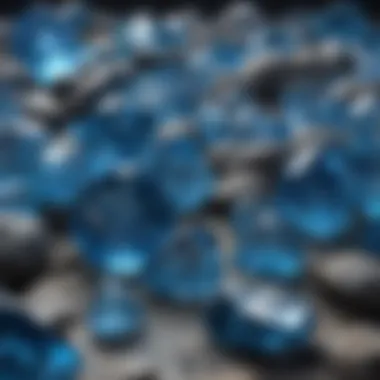
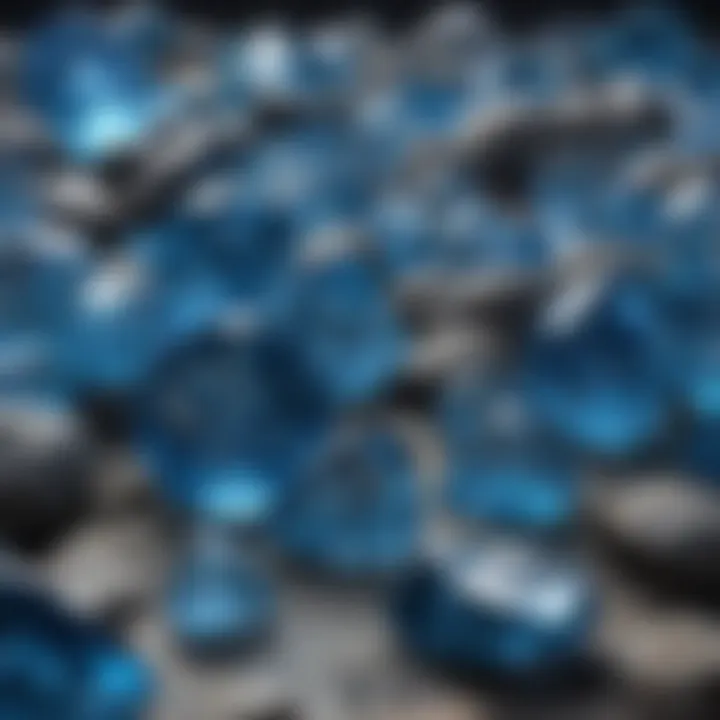
Intro
Clear blue crystal stones have a charm that can be simply mesmerizing. These stunning natural gems are not only visually appealing but also steeped in history and cultural significance. For collectors and enthusiasts, understanding the origins and characteristics of these stones enhances their appreciation and proper care. Knowing what makes these crystals unique opens a door to a deeper connection with nature and the earth's treasures.
In this guide, we will traverse the realms of history, identification, and uses of clear blue crystals. We will shine a light on what sets them apart, delve into their geological formation, and explore their place in various cultures around the world. Collecting these stones is about more than simply having beautiful objects; it’s an exploration of nature, science, and art all rolled into one.
History and Origins
The journey of clear blue crystals starts deep within the earth. These stones manifest from various geological processes, chiefly involving the crystallization of minerals over millennia. Each crystal type has a story written in the rocks that formed them.
Overview of Collectibles, Rocks, and Fossils
Clear blue stones, like aquamarine and blue topaz, belong to a larger family of crystal collectibles. They are often categorized based on their mineral composition and formation. While many collectors focus on aesthetic value, understanding the geological context gives these stones a richer narrative.
- Aquamarine is a member of the beryl family and is often found in metamorphic rocks.
- Blue Topaz typically forms in igneous rocks that are rich in aluminum.
- Larimar, a rare stone from the Dominican Republic, is prized for its unique sky-blue coloration and is formed from volcanic activity.
The fascination with these stones isn’t just for their beauty; it's also about where they come from and how they came into being.
Historical Significance and Cultural Impact
Throughout history, clear blue stones have held significant value across various cultures. For centuries, aquamarine was believed to be the treasure of mermaids and afforded protection to sailors. The soothing color of aquamarine was thought to prevent seasickness—a belief that resonates with the stone's name, which means "sea water" in Latin.
Similarly, in ancient Egypt, blue stones such as turquoise were revered and used in jewelry and burial masks, representing the sky and protection. The symbolism of blue crystals often serves a dual purpose of offering both beauty and spiritual guidance within cultural frameworks, making them treasured belongings across generations.
"Every crystal has a story, etched in the very minerals that create its beautiful form."
As we examine the significance of clear blue crystal stones, we find layers of meaning that go beyond mere visuals. These stones mirror human aspiration and desire, whether for beauty, protection, or deeper spiritual growth.
Identification and Classification
Knowing how to identify and classify clear blue crystal stones is crucial for collectors.
Guide to Identifying Rocks and Fossils
When assessing crystals, enthusiasts should focus on several key aspects:
- Color: While shades can vary, true blue crystals possess distinct tonal qualities.
- Transparency: Clear blue stones typically have a vibrant clarity; inclusions can impact value.
- Hardness: Utilizing the Mohs scale can help assess the mineral's resilience.
- Lustre: A glassy lustre may indicate top quality.
Common Types and Variations
- Aquamarine: Often found in large, transparent forms, it ranges from pale to deep blue, depending on iron content.
- Sodalite: This crystal stands out with its deep royal blue color, frequently mixed with white calcite.
- Iolite: Renowned for its pleochroism, Iolite can showcase violet and blue hues depending on the viewing angle.
By honing identification skills, collectors gain a deeper appreciation for each crystal’s unique identity. This understanding enriches the collecting experience, leading to a more engaged and informed interaction with clear blue stones.
Intro to Clear Blue Crystal Stones
The realm of clear blue crystal stones brings together nature's artistry and human curiosity. These stones, with their mesmerizing hues, captivate collectors and enthusiasts for various reasons. Their appeal isn’t just based on how they look; it's deeply intertwined with their origins, properties, and the stories they tell across cultures and centuries.
To dive in, understanding what makes clear blue crystals unique is essential. Defining clear blue crystals involves recognizing their geological makeup, which varies significantly, leading to a rich tapestry of types and characteristics. This exploration offers not just a glimpse into their physical beauty but also insights into the processes that birthed these remarkable gemstones.
Furthermore, the historical context surrounding clear blue crystals reflects humanity's long-standing relationship with these stones. From ancient civilizations using them for ornaments and talismans to modern crystal healing practices, these stones have always found a prominent place in societal narratives. Their historical lineage adds depth to their allure, prompting deeper inquiry into how they are perceived today and the value we assign to them.
This article seeks to unravel the intricate tapestry behind clear blue crystals, blending scientific insights with historical anecdotes. By doing so, it aims to enrich the understanding of these exquisite natural artifacts among rock and fossil collectors and other hobbyists alike, bridging the gap between aesthetics and appreciation.
Geological Formation of Blue Crystals
The geological formation of blue crystals is a significant element of the allure that's often overlooked by collectors. To truly appreciate these stunning stones, it helps to understand not just their beauty but also the conditions under which they are formed. The intersection of geology and aesthetics provides a richer backdrop, illuminating the natural processes that contribute to their uniqueness. This section explores the mineral composition as well as the various formation processes that give rise to clear blue crystals, shedding light on their complexity and charm.
Mineral Composition
At the heart of any crystal lies its mineral composition. Clear blue crystals are often formed from minerals that possess specific spectral properties allowing them to manifest that signature blue hue. For instance, aquamarine is a variety of beryl, a mineral composed of beryllium aluminum silicate, while blue topaz consists mainly of aluminum silicate fluoride hydroxide. Each mineral brings its own set of physical and optical characteristics, influencing not just their appearance, but also their durability and applications in various fields.
This diversity in mineral composition is crucial, as it determines everything from the crystal's hardness to its brilliance. The elements involved can give hints about the geological history of their formations and where they might be found today. Some collectors might even choose their acquisitions based on a stone's mineral makeup, blending their personal collection with stories that span millennia.
Formation Processes
Metamorphism
Metamorphism refers to the process by which existing rocks are transformed through heat and pressure, creating new mineral alignments and appearances. This process can generate beautiful clear blue crystals, especially in places where specific conditions are right, like deep within the Earth’s crust. The key characteristic of metamorphism is its transformative nature, making it a popular choice for understanding how blue crystals develop under extreme conditions.
A unique feature of metamorphosed stones is their layered appearances, sometimes revealing stunning patterns within. This aspect can be quite appealing to collectors, offering a glimpse into the geological drama that occurred during its formation. However, it’s worth mentioning that while metamorphosed gems can be striking, they may also be more brittle compared to their igneous counterparts, introducing challenges in cutting and polishing.
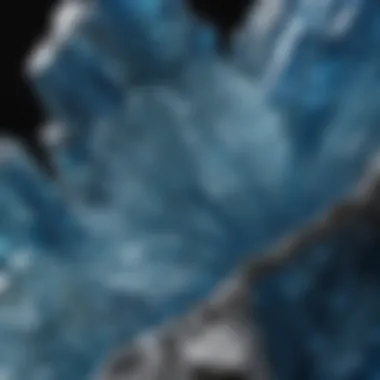
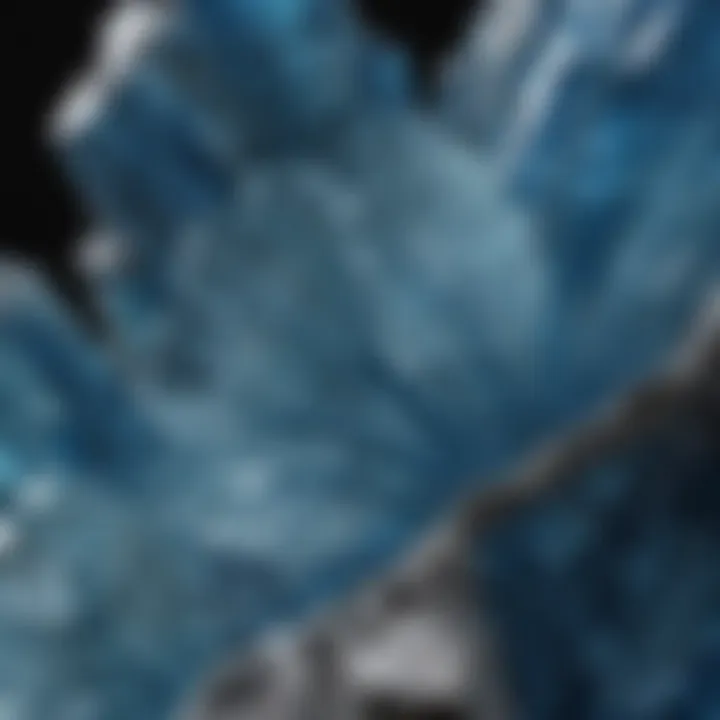
Volcanism
Volcanism plays a vital role in the formation of some clear blue crystals. When magma erupts and cools rapidly, it can form rocks that eventually crystallize under various conditions to yield beautiful stones like blue topaz. The rapid cooling characteristic of volcanic activity often leads to a distinct clarity that showcases the mineral’s true color and brilliance.
With volcanism, one of its prominent features is the fact that it often leads to the creation of gems in bulk, making it a beneficial geological process for collectors. The unique feature here is the ability to discover numerous types of blue crystals in a single volcanic region. However, volcanic minerals may present challenges in sourcing, as they can be scattered in varied locations after eruptions.
Sedimentation
Sedimentation, on the other hand, involves the gradual accumulation of minerals settling from water. This process can produce beautiful clear blue crystals like lapis lazuli, which forms in sedimentary environments rich in specific minerals such as lazurite. Notably, sedimentation is influential because it often involves the layering of various materials, resulting in the development of multi-faceted stones.
The key characteristic of sedimentary formations is their stratified nature, which could yield gems with intriguing historical aspects embedded in their layers. A significant advantage of sedimentation is that it often leads to large deposits, making it easier for collectors to find quality stones. However, it can sometimes mean that the stones need careful extraction to retain their integrity, which is an important consideration for both collectors and jewelers interested in these gems.
Varieties of Clear Blue Crystal Stones
The world of clear blue crystal stones is as diverse as it is vibrant. Each type carries its own unique properties and histories, captivating the hearts of collectors and enthusiasts alike. Understanding these varieties is key, as it allows collectors to appreciate not just their aesthetic beauty but also their geological narratives and cultural significance. From the soothing hues of aquamarine to the rich depths of lapis lazuli, each stone in this spectrum offers something distinctive for both new and seasoned collectors.
Aquamarine
Aquamarine, a member of the beryl family, is cherished for its stunning sea-blue color reminiscent of tranquil ocean waters. This gemstone is often associated with calmness and clarity. Its transparency ranges from crystal clear to slightly opaque, making it highly sought-after in jewelry-making. Notably, aquamarine's hardness, rated at 7.5 to 8 on the Mohs scale, contributes to its durability, making it ideal for everyday wear.
Collectors should keep an eye out for the deeper blue variations, which tend to command higher prices. Additionally, the stone is believed to carry protective qualities, particularly for those who travel by water. The ancient Romans even thought it served as a talisman for sailors, making it a fascinating piece to add to any collection.
Blue Topaz
Blue topaz, with its captivating shades that can range from light sky blue to a rich London blue, is another gem that captivates many. A unique aspect of blue topaz is that its majority is treated to achieve its vibrant hues through a process involving heat and irradiation. Ratings place it at around 8 on the Mohs hardness scale, so it’s more than just a pretty face.
This stone often stands out in jewelry due to its brilliance and affordability compared to other blue stones. It’s commonly used in cocktail rings and pendants. Collectors might consider the nuances of color saturation and clarity, which can significantly influence value. Just remember, while it’s stunning etched in silver or gold, it’s the stone’s natural brilliance that truly shines through.
Iolite
Iolite is sometimes referred to as "the Viking's sapphire" due to its historical usage in navigation. A pleochroic stone, it exhibits different colors when viewed from different angles, primarily displaying hues of violet blue, gray, and even yellow. This unique characteristic lures in collectors interested in distinctive visual phenomena.
Rated at 7 to 7.5 on the Mohs scale, Iolite is reasonably durable, but collectors need to be careful with its cut; a well-cut stone can reveal its true color magnificently. Many hold a belief that Iolite promotes introspective qualities and enhances one's inner wisdom, integrating both spiritual and visual allure in one package.
Lapis Lazuli
Lapis lazuli is a striking stone that has dazzled civilizations for thousands of years. It is often recognized for its deep, rich blue color flecked with gold pyrite and white calcite. Unlike some other blue crystals, lapis lazuli is not a singular mineral but a rock composed mainly of lazurite.
Historicallyused by ancient Egyptians in amulets and cosmetics, its significance spans many cultures, symbolizing royalty and wisdom. Being softer than most other blue stones, rated at 5 to 5.5 on the Mohs scale, it requires careful handling. Collectors should also pay attention to the piece's quality, with well-defined pyrite inclusions usually enhancing its overall aesthetic appeal. It's a piece that blends history with beauty, undeniably boosting any collection.
"The magic of blue crystals lies not just in their colors but in the tales they weave and the energies they wield."
In sum, understanding the diverse varieties of clear blue crystal stones enriches one’s collection experience. Each stone tells a story of geological wonder and human appreciation that resonates deeply. Enthusiasts should always be on the lookout for unique specimens that speak to them personally while considering their significance and value in the market.
Properties and Characteristics
Understanding the properties and characteristics of clear blue crystal stones is essential to appreciating their value and beauty. These aspects define not just their physical appeal, but also their practical applications in various fields such as jewelry making, healing practices, and even industrial uses. Delving into the optical and physical properties reveals the depth of their allure and informs potential buyers and collectors about what to look for when acquiring these stunning stones.
Optical Properties
Transparency
A clear blue crystal's transparency is its most striking feature. This quality can have a significant impact on its visual appeal. Transparency contributes to how light interacts with the stone, allowing it to sparkle and reflect with a brilliance that can capture one's eye. In this context, high transparency is a beneficial attribute, as it means the stone exhibits fewer inclusions or imperfections that might cloud its clarity. This feature grants each stone a unique brilliance, often making them highly sought after in the market.
The best examples of transparency can be seen in stones like aquamarine, where the clarity allows for exceptional light play. However, one should be cautious, as stones that are overly transparent may also be more prone to damage due to impacts. Thus, while transparency elevates aesthetics, it also necessitates mindful handling.
Color Variations
Color variations in clear blue stones serve as a visual feast. The varying shades, from pale sky blue to deep ocean hues, impact their desirability and perceived value. These differences can arise from mineral impurities or the specific geological conditions during their formation. For many collectors, the specific shade of blue can be a determining factor in purchasing a stone.
This feature is advantageous because it allows personalization; enthusiasts can find a shade that resonates with them, making it more than just a collectible but a personal artifact. However, one must be aware that more saturated colors, while visually striking, may be less common, hence they could carry a higher price tag.
Refractive Index
The refractive index of a clear blue crystal stone is a crucial measure in understanding how light bends as it enters the stone. A higher refractive index typically indicates greater brilliance and sparkle, important characteristics that enhance the stone's allure. In this article, stones like blue topaz showcase excellent refractive qualities, making them highly desirable among collectors.
However, it’s necessary to note that stones with extremely high refractive indices often are more challenging to cut and facet, potentially leading to higher costs. Thus, collectors not only admire the beauty but must also consider the technicalities behind crafting such stones.
Physical Properties
Hardness
Hardness measures a crystal's resistance to scratches and wear, which is vital for both daily wear in jewelry and for collectors' displays. The Mohs scale ranks stones based on their hardness, and many blue crystals, such as sapphire, score quite high, making them durable choices. This quality is appealing because it suggests long-lasting beauty and fewer concerns about damage over time.


Yet, it’s prudent to note that even hard stones can chip or break if they are subjected to significant force. Hence, understanding the hardness factor can temper expectations and guide appropriate care practices.
Cleavage
Cleavage refers to the way a stone breaks along specific planes of weakness. Stones with good cleavage can split neatly, making them more desirable for certain types of cuts. For instance, lapis lazuli has unique cleavage properties that can enhance the stone's appeal when polished.
However, this feature can be a double-edged sword. While it may aid in creating stunning pieces, it also means that the stone can be more fragile in certain orientations. Therefore, collectors should be mindful of how they store and display these stones to avoid unintentional breaks.
Fracture Patterns
Fracture patterns indicate how a crystal breaks when it does not split along the cleavage planes. Recognizing each unique pattern allows a collector to gain deeper insight into the stone's structure and potential weaknesses. Stones like iolite exhibit unique fracture patterns that are not only fascinating but also impact how they can be cut and used in jewelry.
While these patterns can add character and uniqueness to the stone, they may also compromise its structural integrity. Being aware of these characteristics helps in making informed decisions about care, versatility, and display applications.
Understanding the properties and characteristics of clear blue crystals not only adds to their allure but also to their practical usage in various applications, from jewelry design to holistic practices.
In summary, a clear blue crystal’s allure lies deeply embedded in its optical and physical properties. Whether you are a seasoned collector or a casual admirer, these attributes inform and enrich your experience with these remarkable natural artifacts.
Cultural and Historical Significance
The cultural and historical significance of clear blue crystal stones is multi-faceted, underscoring humanity's long-standing fascination with these natural wonders. These stones have been more than mere decorative pieces across civilizations; they have served as conduits for social identity, commerce, healing, and even spirituality. The connection people have had with these crystals stretches back to ancient times, where their physical beauty was often paired with perceived mystical properties.
Usage in Ancient Civilizations
In ancient civilizations, clear blue crystals were often revered and used in various practical and symbolic ways. The Egyptians, for example, prized lapis lazuli not just for its stunning blue hue but also for its believed protective qualities and association with the divine. As far back as 4000 BC, they used it in jewelry and burial masks, believing it held power in the afterlife. Similarly, the Aquamarine was said to bring good luck to sailors, often finding its place in the amulets worn by them.
The Mesopotamians also utilized blue stones, carving intricate seals from blue topaz that were used in trade. They recognized these stones as not only beautiful, but as a source of connection to the spiritual realm as well, using them in rituals intended to promote fertility and safety. This tells us that even back then, the allure of clear blue crystal stones was tied to both aesthetic pleasure and deeper symbolic meanings.
Symbolism and Myths
Jumping into mythology and symbolism, clear blue crystals have carried rich narratives throughout history. For instance, Iolite has been associated with the Viking navigators, who believed it offered clarity in direction, enabling them to traverse the vast seas. This stone became a guide of sorts, representing vision and understanding, which is especially significant in both literal and metaphorical navigations of life.
Moreover, many cultures attribute various meanings to the blue hue. For example, blue is often associated with wisdom, trust, and spirituality, conveying a sense of calm and clarity. In some Native American traditions, for instance, turquoise epitomizes communication and healing, symbolizing harmony and balance. These myths intertwined with the stones increased their value, making them items not just of beauty but of profound significance.
Modern Interpretations
In more contemporary times, the allure of clear blue crystal stones has taken on new dimensions. Nowadays, rock and fossil collectors appreciate these gems not only for their aesthetic appeal but also for their multitude of metaphysical properties, which enthusiasts often showcase in social settings. Some believe that wearing or carrying these stones can result in emotional healing and inspiration. Blue topaz, for example, is frequently linked to effective communication, enabling wearers to express their thoughts clearly.
With the rise of wellness culture, many have turned to crystal healing practices, integrating these blue stones into meditation and energy cleansing techniques. The appreciation for these stones spans far beyond mere physical attributes, as practitioners often highlight their meditative benefits. Collectors, then, find themselves engaged in a cycle of exploration, connection, and continued fascination with these age-old treasures.
"The beauty of clear blue crystals transcends their physical appearance, linking us to ages past and shaping our modern reality."
As collectors continue to delve into the history and significance of these stones, the threads they weave through time remind us that their allure is ever-present, securing a place in both the past and the future of human culture.
Role in Crystal Healing
The significance of clear blue crystal stones in the realm of healing practices is both profound and multifaceted. For many enthusiasts, these crystals are not just decorative pieces; they serve as conduits for emotional and physical well-being. This section seeks to illuminate the vital role these stones play in crystal healing, exploring both their historical context and contemporary applications.
Beliefs and Practices
Throughout history, various cultures have held strong beliefs about the metaphysical properties of crystals. Clear blue stones, in particular, are often associated with calm and tranquility. Practitioners believe that these stones can help to balance emotions and induce a serene state of mind. Whether one is new to the world of healing crystals or a seasoned collector, understanding the underlying beliefs can deepen one's appreciation for these gemstones.
Say someone stumbles upon a striking aquamarine. It’s not just the aesthetics; there’s a story behind it. People might believe that by holding such stones, they are tapping into a flow of positive energy. This connection fosters a sense of community among crystal enthusiasts, united by shared beliefs and practices. Each stone tells a tale, and the lore surrounding them enriches the experience of healing.
Types of Healing Techniques
Healing with clear blue crystals can take many forms. Below are two widely recognized techniques:
Chakra Alignment
Chakra alignment is an essential component of many healing practices. The concept revolves around balancing the body's energy centers, known as chakras. Clear blue stones, like blue topaz, are linked to the throat chakra, the center of communication. When the throat chakra is balanced, practitioners often report enhanced self-expression and clarity of thought. This particular association makes chakra alignment a sought-after technique for those drawn to personal development and emotional health.
The advantage of using clear blue stones for chakra alignment lies in their calming energies. One notable feature is their ability to promote open dialogue—not just with others, but also internally. However, one should keep in mind that the effectiveness can vary among individuals and requires a degree of personal experimentation to achieve desired outcomes.
Energy Cleansing
Energy cleansing is another prevalent method, which purports to remove negative energies that may latch onto both people and spaces. Clear blue crystals are often utilized in this practice for their purported ability to refresh and rejuvenate energy fields. The core idea is simple: by using these stones, one might cleanse their surroundings and restore a sense of peace.
A key characteristic of energy cleansing with blue crystals is the visual aspect. Many prefer to visualize blue light washing away negativity, making meditation experiences richer. Additionally, energy cleansing can readily be incorporated into daily routines, taking merely a few moments to reflect with a crystal in hand. That said, while the concept is appealing, skeptics might question the tangible effects of such practices. The debate continues, and the decision to embrace or dismiss these techniques lies with the individual.
"Crystals aren't healing themselves, but they act as a tool to aid those who seek balance and clarity."
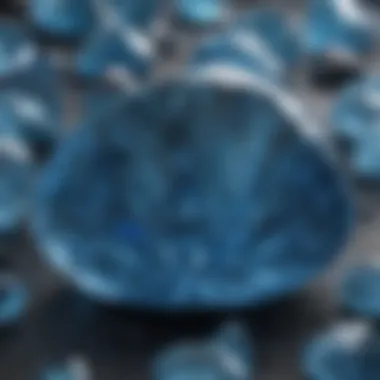

Collecting Clear Blue Crystals
The world of collecting clear blue crystals is more than just a hobby; it's a passionate pursuit that connects one to the elements of Earth and the mysteries held within these beautiful stones. People are drawn to these gems not just for their aesthetic appeal but also for the rich historical and cultural narratives that accompany them. So, why exactly should you consider adding clear blue crystals to your collection? First and foremost, they hold visible and hidden value that resonates with enthusiasts and collectors alike. Developments in geological understanding, market trends, and unique healing properties intertwined with personal beliefs make this a fascinating venture.
Identifying Authentic Stones
When venturing into the realm of collecting clear blue crystals, one of the first and foremost skills to hone is the ability to identify authentic stones. There are numerous fakes and imitations in the market today, and being well-versed in the characteristics of genuine blue crystals is imperative. First, observe the stone’s color – authentic pieces like aquamarine or blue topaz exhibit vibrant yet natural hues. If the color looks overly uniform or resembles a synthetic prize, you might want to tread cautiously. Examine the clarity as well; true blue gemstones will often feature slight inclusions, telling a story about their origin. Growing knowledgeable about the origins and variations of these stones helps you make informed purchasing decisions, effectively protecting your collection from undesirable duplicates.
Valuation Tips
Market Trends
Understanding market trends is an essential part of collecting clear blue crystals. Just like stock prices, the value of these gems can fluctuate over time. Factors influencing these shifts include demand, supply, and even the economic climate. For instance, an increase in interest around holistic healing has sparked a rise in prices for stones believed to have healing properties, such as lapis lazuli. Collectors should always stay attuned to these shifts. Regularly visiting gem fairs or participating in online discussions on forums like Reddit can gauge the current popularity of specific stones. Additionally, observing auction sites might reveal what enthusiasts are willing to pay, providing valuable insights on valuation. One must also consider that certain types of stones, due to their rarity and historical significance, maintain steady appreciation over time.
Factors Influencing Value
Many factors contribute to a stone's value, often intertwining to create a complex picture. For example, clarity plays a vital role. A crystal that is perfectly clear usually fetches a higher price than one with noticeable inclusions. The cut also plays a part; how a stone is shaped can highlight its natural beauty, enhancing its appeal and increasing its desirability. Rarity cannot be overlooked either; some stones are simply harder to procure due to limited geological deposits, elevating their status in the collector community. As with any investment, understanding these nuances prepares collectors for well-informed purchases. Additionally, considering how trends evolve over time can help anticipate which stones may become more valuable in the future.
Collecting clear blue crystals is an art form that encompasses much more than possession – it’s about understanding, valuing, and connecting with Earth's history embedded in these stones.
Caring for Clear Blue Crystals
Caring for clear blue crystals holds great significance for collectors and enthusiasts alike. These stunning stones are not just eye candy; they are natural treasures that speak volumes of the earth’s history. Taking proper care is essential to preserve their beauty and enhance their appeal. Without proper maintenance, these majestic stones may lose their luster, leading to a less satisfying collection experience. By investing time and effort into their care, you not only protect your investment but also deepen your appreciation for these unique geological specimens.
Cleaning Methods
Regular cleaning of clear blue crystals is crucial to maintain their clarity and brilliance. Various methods can be employed, depending on the type of crystal and its specific needs. Here are some tried-and-true techniques:
- Gentle Soap Solution: Using mild soap mixed in warm water can effectively remove dirt and fingerprints. Avoid potent chemicals that can cause damage, especially to softer stones.
- Soft Brush: After soaking the stones, gently scrub with a soft-bristled toothbrush to get into the crevices. Pay close attention to intricate facets; the detail here is where the magic lies.
- Natural Cleaning Agents: Some collectors swear by a mixture of vinegar and water for cleaning, though it’s best to do a spot test first. This natural solution can brighten stones like aquamarine and blue topaz without harsh chemicals.
- Avoiding Heat: Rinse with cool water afterward; avoid high temperatures that can cause cracks in more delicate crystals.
"Cleaning your crystals is like giving them a fresh breath of life. It reminds you of their unique beauty, which comes from nature itself."
Storage Guidelines
Storing clear blue crystals properly is as important as cleaning them. When not on display, how you store these stones can make a world of difference:
- Separate Compartments: Store different types of crystals in separate compartments to avoid scratching. A simple organizer or tackle box can work wonders.
- Breathable Bags: Use fabric pouches instead of plastic. Natural materials allow the stones to breathe, reducing moisture accumulation which can lead to damage.
- Avoid Direct Sunlight: Store in a cool, dark place away from direct sunlight. UV rays can alter the colors of some stones over time, diminishing their vibrant hues.
- Regular Inspections: Every so often, take time to inspect your collection. Look for any signs of wear or damage. Early detection can save you from bigger issues down the road.
By adhering to these care methods and storage strategies, you will ensure that your clear blue crystals remain captivating pieces in your collection for years to come.
Showcasing Your Collection
Showcasing your collection of clear blue crystal stones is more than just a presentation; it’s a celebration of the beauty, uniqueness, and stories each piece carries. For enthusiasts, having a commanding display not only enhances the visual appeal of their collection but also serves as a means to share their passion with others. Doing right by your crystals reflects the respect and admiration you have for these natural wonders.
When arranging your display, consider factors such as lighting, accessibility, and thematic coherence. A well-thought-out showcase can transform your collection into a conversation starter, drawing in fellow collectors, friends, and family who appreciate the allure of these exquisite stones. A captivating display speaks volumes about your commitment to crystal collecting and can inspire others to delve into this fascinating hobby.
Display Techniques
There are several techniques you can employ to showcase your clear blue crystal stones beautifully:
- Tiered Displays: Using shelves of varying heights can create a more dynamic appearance, allowing larger pieces to take center stage while smaller crystals fill in the gaps.
- Light Enhancements: Proper lighting may completely change how your crystals are perceived. Using spotlights or LED strips can accentuate the refractive qualities of your stones.
- Natural Elements: Incorporating natural materials, such as driftwood or stones, can provide an earthy contrast that highlights the crystals instead of competing with them.
- Glass Cases: For rare or valuable specimens, a glass display case protects the stones while allowing them to be seen. This ensures they remain free from dust and potential damage.
- Thematic Arrangements: Organizing your collection by type, color, or origin can help convey a story or journey through your collection, making it even more engaging.
Photography Tips
Capturing your collection through photography can further extend its reach beyond the physical display. Good photography can showcase the details and brilliance of your crystals that the naked eye might miss. Here are some effective tips to photograph your clear blue crystals:
- Natural Lighting: Try to shoot during daylight to take advantage of soft lighting. Avoid harsh direct sunlight which can create unwanted shadows and reflections.
- Background Choice: Keep backgrounds simple and uncluttered. White, black, or neutral colors work best to allow the crystals to shine.
- Use a Tripod: Stability is crucial when taking close-ups. A tripod helps avoid blurry images and allows for better focus on intricate details.
- Experiment with Angles: Different angles can create varying perspectives. Play around with heights and distances to find the best representation of your pieces.
- Macro Settings: If your camera has a macro feature, use it to capture the fine details of the stone's texture and color variations more closely.
"Showcasing and photographing your crystal collection invites not just admiration but a tangible connection to the beauty of nature’s creations."
Finale
Delving into the world of clear blue crystal stones reveals a rich tapestry of beauty, history, and significance. Understanding these captivating gems is not just an exploration of their aesthetics but also a journey into their cultural contexts and geological backgrounds. The allure of these crystals stretches beyond their visual appeal, offering benefits that resonate with enthusiasts, collectors, and those drawn to their healing properties.
The Ongoing Fascination
The fascination with clear blue crystals has maintained its grip on individuals from various walks of life, be it gem collectors or casual admirers. This intrigue stems from many elements. The sheer beauty that a well-cut aquamarine can exhibit or the deep blue of lapis lazuli captivates all who bear witness to their splendor. Furthermore, the stories that accompany each crystal—from ancient civilizations to modern-day practices—underscore a continuity of human emotion and cultural significance. Collectors savor not only the stones themselves but also their narratives, merging them into personal journeys of discovery.
As these gems come to life in various settings—be it through displays in a living space or the intimate touch of crystal healing—their allure continues to grow. This ongoing fascination is anchored in a blend of art, science, and spirituality, ensuring that these stones remain significant in contemporary culture.
Future of Collecting Blue Crystals
Looking ahead, the art of collecting clear blue crystal stones stands at a crossroads of tradition and innovation. New techniques in gemology offer insights into authenticity, helping enthusiasts identify genuine stones amidst an ocean of imitations. Additionally, as digital platforms broaden access to resources and marketplaces, collectors can connect with global communities, enhancing their knowledge and enriching their collecting experiences.
In the realm of sustainability, the future may see an emphasis on ethical sourcing and nurturing of these natural artifacts. This growing awareness pushes collectors to invest in stones that not only possess beauty but also adhere to responsible and sustainable practices.
Engagement in online forums, such as those found on Reddit, and participation in exhibitions can also bolster this community's experiences, enabling them to exchange knowledge and expand their collections wisely.
Ultimately, as market trends shift, one thing remains clear: the future of collecting blue crystals is bright. As long as their captivating stories and stunning visuals continue to spark interest, collectors will cherish these stones long into the future.



